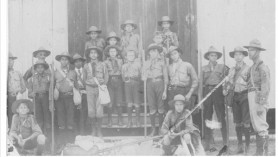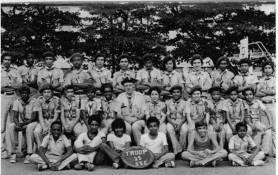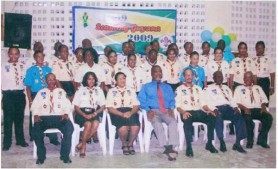Nostalgia 460
By Godfrey Chin
“On my honour, I promise that I will do my best, to do my duty, to God and my country, to help other people, and to keep the scout law.” This has been the solemn pledge of thousands of scouts – Guyana’s sons and daughters these past hundred years.

Scouting started in British Guiana in 1909 two years after it was founded in England by Sir Robert Baden-Powell. This was the first country in the Caribbean where it was established, and the second in South America. The initial scout troop was founded at Queen’s College, by Sgt Major George Manley, a member of a British regiment stationed here, and scouting soon spread to other schools and churches. By mid-century there were over 25 troops in BG, many initiated by church groups. These included Queens, St Mary’s, St Theresa’s, St Stanislaus, St Francis, St Thomas More, HQ Troop 39, St Pius and Central High in Georgetown.
Three years after scouting had been introduced here, the first Jamboree Camp was held locally. By the 3rd World Scout Jamboree in 1929 at Arrow Park, England, BG was represented by Dick Driver, Basil and Leslie Evan Wong, Irving Crum-Ewing and Harbour Master Mittelholzer.
Rev Firth was instrumental in the formation of Troop 39, headquartered at Scouts Ground

adjacent to the former EICC ground, which produced some of Guiana’s finest scout leaders including two Chief Commissioners, DB St Aubyn and Lawrence Thompson, as well as four Assistant Chief Commissioners for cubs. In the late 1920s Dick and brother James Driver, together with Lawrence and Adrian Thompson were the first organised group to climb to the top of Kaieteur Falls. The area where they camped out is now designated ‘Boy Scouts View.’
Scouting soon spread to Berbice where the renowned, Lady Dawson’s Own was founded, and by 1940 a troop was started at Onderneeming Boy’s School, Suddie, while there were other packs in the Pomeroon, Rupununi and in Kamarang, Upper Mazaruni. The Kamarang Troop run by Canon John Dorman, a Gillwellian, catered mainly for Amerindian boys.
The scout movement benefited immensely from the fact that many of the Anglican and Roman Catholic priests who came from England to serve in Guiana were Gilwell scouters, including the Archbishop of the West Indies, Dr Alan John Knight, who served on the Colony Scout Council for many years.

The national training team was started in 1947 with Clement ‘Skip’ Gomes, John Teixeira, Lawrence Thompson and Fr Chadwick. In later years it was expanded to include Hugh Chan, Ivan Smith-Greene of Central High School Troop and Elsie Taylor of Troop 39. In 1951 the first training course for scout leaders was held by John McGregor. Mr Harold Dahl, from Gilwell Park, England, arrived in 1954 to conduct several courses. Lady Baden-Powell, the wife of the founder of the scout movement and founder of the Girl Guides Movement visited Guiana also.
Initially many local official trainers were required to attend courses at Paxvale, Trinidad, but by 1955 Brian Fox was seconded from England and spent two years training scouts, scout leaders and administrative members of the association. Other trainers sent out from Gilwell Park included John Thurman, Camp Chief, 1958, and George Wilchell in 1964. In 1966 the Chief Scout Sir Charles Maclean, the first successor to Lord Baden-Powell visited British Guiana.
The first World Scout Indaba – a conference for scout leaders from around the world – was held at Gilwell Park in July 1952 in the UK. The second Indaba was held at Sutton Coldfield, UK.
In June 1957, combined with the 9th World Scout Jamboree and the 6th World Rover Moot to celebrate 50 years of scouting, BG was represented Michael DeMendonca.
British Guiana was represented at the 3rd World Indaba in Holland by 8 Scouters – Edwin Elcoat, Michael Perreira, Joan Gilkes, Teddy Boyce, Michael DeFreitas, Joe Mungal, Jerry Young and Theresa Gonsalves. The Scout Association of Guyana joined the World Organisation of the Scout Movement in 1967 by which time Guyana was able to boast of Land, Sea and Air Scouts and Rovers. John Teixeira had previously started the Air Scouts Troop in 1954 and this was later taken over by Scout Masters Joel Pollard and Harry Lall. The Sea Scouts were started around 1934-35 by Capt Fraser and Harbour Master Mittelholzer.
By the early sixties scouting in BG began to peak in spite of the civic and political upheavals of the times. The Guiana contingent to the 11th World Jamboree, 1963, in Greece included George Rickford, Martin Bowen, Harry Lall, Michael DeFreitas, LB Thompson, Teddy Boyce, Joel Pollard and I Crum-Ewing.
In 1959 Father Harold Wong resuscitated St Stanislaus Troop 25, and by the 3rd Caribbean Jamboree – celebrating the 50th Anniversary of Scouting – St Stanislaus Own was one of the leading troops in the nation.
Father Darke took over as scout leader in 1962 and managed the college troop until his death in 1979. He trained his senior scouts so well that for several years the troop was run by senior scouts after his death.
Elsie Taylor, wife of Peter Taylor, former Editor of the Evening News, dedicated her life to scouting in Guyana, and for many years kept the movement alive in spite of constraints and a period of near dormancy in the seventies. Her motivational skills were exceptional, and she endeared herself to every scout in Guyana being their ‘second mother’ and mentor. DB St Aubyn, MBE, Commissioner 1952 was very instrumental in acquiring the present scout headquarters on Woolford Avenue, Thomas Lands.
The 3rd Caribbean Jamboree held at the Queen Elizabeth Park, (later National Park) was a memorable affair, and probably one of the best in this hemisphere. Contingents came from Canada, England and all the Caribbean Islands. Sir David Rose was the Chief Patron and it is estimated that over 1500 scouts participated.
Dr Alwyn Egbert, now resident in Toronto, Canada, former Queen’s Scout of Queen’s College 1950-55 shares his experience as a scout yesteryear.
“My Scout Master (SM) was Reg Butler. This period of my life was most enjoyable, very educational and highly rewarding. I think the discipline engrained in my mind from reciting the Scout Promise and living by the 10 laws moulded my character and has served me well in my continued journey through life.
“I became interested in scouting because of the attraction to outdoor activities and comradeship that it provided.
“I started as a tenderfoot and progressed after a series of tests acquiring badges in various programmes (axemanship, astronomy, first aid, fireman, etc) to 1st and 2nd class, eventually to Bushman’s Thong, and Queen’s Scout. My Queen’s Scout certificate is one which I have framed, cherished and hangs in a prominent place in my home. The words act as an inspiration – ‘God speed on your journey through life’ signed by Elizabeth R
“I feel that children in Guyana and worldwide, would benefit greatly if the scouting movement was revitalized. Youths would be fully occupied and would be involved in physical and educational activities rather than being distracted by unpleasant anti-social past times.
“The best local achievers in scouting in my period were the late William Wordsworth McAndrew, Lionel Samuel, Ray Lee, Hugh Chan, Michael Osborne, Michael Too Chung, Johnny Lee, Lawrence Van Sertima, only to mention a few brothers. We all owe a sense of gratitude to scout masters like Reg Butler, CC Lewis, Clement Gomes (Skip), Lawrence Thompson, Brian Fox, Neil Mendonca, Ivan Smith-Greene, Joel Pollard, Richard Driver, Teddy Boyce, Michael DeFreitas, etc.
“The competition among the various troops was indeed challenging, especially during the rallies. The relationship with the girl guides was also one that we cherished and respected.
I vividly recall, however, a certain rally at 63 Beach, Berbice, where the various troops competed and Troop 27 was in the finals against the Central High School Troop for the Signalling Trophy. I was moving my arms and flags so fast in various clock directions that for days after it was painful to even lift my hands to eat. I still get nightmares about me standing on a mound trying to send and receive semaphore signals to and from my partner!”
By the mid-seventies the Guyana National Service was introduced and attracted many experienced scouters to their ‘payroll.’ At that time with the government take-over of the schools, Catholic and Anglican clergy re-migrated, etc. Scouting was on the wane and its ranks gradually reduced to less than 500.
The present local committee headed by Ron Robinson, Zaida Joaquin, Reeza Joaquin, Dominique Van Sluytman, Andrew Ramcharitar, Charissa Rampersaud, Gary and Sean Mendonca, and Nilofar Rampersaud must be complimented on their indefatigable effort to keep scouting alive and vibrant. Today there are approximately 15 troops in the country and an estimated 300 participants.
The continued propogation of scouting locally will certainly uplift the moral and social conduct of Guyana’s youth.









